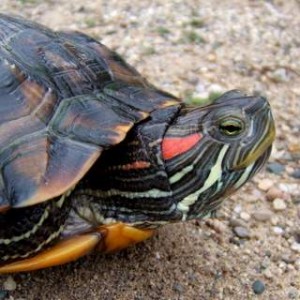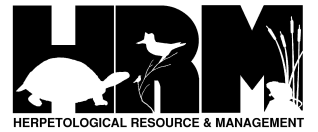Red-eared Slider
Overview:
Scientific Name: Trachemys scripta elegans
Size: 5 – 11.4” (adult carapace length)
Status: Generally common throughout most of its range, but restricted to widely scattered and very localized populations across the Great Lakes region.

Habitat:
Ponds, lakes, reservoirs, ditches, sloughs, swamps, and backwaters and slower sections of streams and rivers. Will occupy almost any permanent body of water with ample aquatic vegetation and basking sites. Rarely far from water, but will travel over land. Adults tend to prefer somewhat deeper water than Painted Turtles in same habitats, though juveniles of both species remain in weedy shallows.
Adult Coloration:
Brownish or olive carapace with variable pattern of yellow and black bands and stripes. Plastron yellow, usually with dark spot or smudge in center of each scute. Head and legs green, olive, or brown, with many narrow black and yellow stripes. A few broad yellow stripes slant downward from snout, mouth, and lower corner of eye, and broad red or orange stripe extends backward from center or top of each eye. In some individuals this may be poorly developed or obscured. Large males often become very dark, with black pigment obscuring color and pattern on shell and skin.
Adult Characteristics:
Carapace smooth and may be unkeeled or have a low central keel, with flaring rear edge weakly serrated. Male is smaller than female and has greatly elongated claws on front feet and comparatively longer tail.
Juvenile Characteristics:
Range from 1.1 – 1.3” in carapace length. Shell with low keel, and both carapace and legs bright green. Yellow stripes and other markings may be less defined by dark pigment than those of older turtles, but black spots on plastral scutes usually prominent.
Species Confused With:
Painted Turtles have reddish markings on marginal scutes and limbs, and centralized blotch or pattern on plastron. Common Map Turtles lack red stripe behind eye and have mostly unmarked plastron.
References:
- Amphibians and Reptiles of the Great Lakes Region by Jim Harding
- Harding, J.H. and J.A. Holman. 1990. Michigan Turtles and Lizards. MSU Cooperative Extension Service and MSU Museum. 96 pp.
- Ruthven, A. G., H. B. T. Gaige, et al. 1912. The herpetology of Michigan, by Alexander B. Ruthven. Crystal Thompson and Helen Thompson; Memoranda towards a bibliography of the archaeology of Michigan, by Harlan I. Smith; prepared under the direction of Alexander G. Ruthven. Lansing, Mich., Wynkoop Hallenbeck Crawford, State Printers.
- Holman, J. A. 2012. The Amphibians and Reptiles of Michigan: A Quaternary and Recent Faunal Adventure. Detroit, Mich., Wayne State University Press.
- Conant, R., and Collins, J. T. 1998. Reptiles and Amphibians: Eastern, Central North America. Houghton Mifflin Harcourt Press.
Credits:
- Jim Harding
